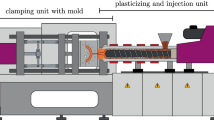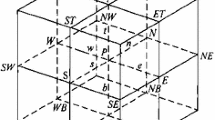Abstract
With the development of molding techniques, molded parts have more complex and larger geometry with nonuniform thickness. In this case, the velocity and the variation of parameters in the gapwise direction are considerable and cannot be neglected. A three-dimensional (3D) simulation model can predict the filling process more accurately than a 2.5D model based on the Hele–Shaw approximation. This paper gives a mathematical model and numeric method based on 3D model to perform more accurate simulations of a fully flow. The model employs an equal-order velocity–pressure interpolation method. The relation between velocity and pressure is obtained from the discretized momentum equations in order to derive the pressure equation. A 3D control volume scheme is used to track the flow front. During calculating the temperature field, the influence of convection items in three directions is considered. The software based on this 3D model can calculate the pressure field, velocity field and temperature field in filling process. The validity of the model has been tested through the analysis of the flow in cavities.








Similar content being viewed by others
References
Gotoh Terumasa, Iizuka, Miyamoto Masayuki et al (1986) Simulation of polymeric flows in the cavity filling process of injection molding. Sharp Tech J 34:63–70
Schlichting H (1968) Boundary-layer theory. McGraw-Hill, New York
Chen BS, Liu WH (1989) Numerical simulation and experimental investigation of injection mold filling with melt solidification. Polym Eng Sci 29:1039–1050
Dequn L (2002) New progress of flow simulation for plastic injection molding. China Int Forum Die Mould Technol 5:47–48
Huamin Z, Dequn L (2002) Computer filling simulations of injection molding based on 3D surface model. Polym Plast Tech Eng 41:91–1021
Hiebert CA, Shen SF (1980) A finite-element/finite-difference simulation of injection molding filling process. J Non-Newtonian Fluid Mesh 7:1–32
Inoue Y, Higashi T, Matsuoka T (1996) Numerical simulation of 3-dimensional flow in injection molding. ANTEC Proc 1:744–748
Pichelin E, Coupez T (1998) Finite element solution of the 3D filling problem for viscous incompressible fluid. Comput Methods Appl Mech Eng 163:359–371
Hwang CJ, Kwon TH (2002) A full 3D finite element analysis of the powder injection molding filling process including slip phenomena. Polym Eng Sci 42:33–50
Prakash C, Patankar SV (1985) A control volume-based finite-element method for solving the Navier–Stokes equations using equal-order velocity–pressure interpolation. Numer Heat Transfer 8:259–280
Prakash C (1986) An improved control volume finite-element method for heat and mass transfer, and for fluid flow using equal-order velocity–pressure interpolation. Numer Heat Transfer 9:253–276
Rice JG, Schnipe RJ (1986) An equal-order velocity–pressure formulation that does not exhibit spurious pressure modes. Comput Methods Appl Mech Eng 58:135–149
Hieber CA (1987) Injection and compression molding fundamentals. Marcel Dekker, New York
Tadmor Z, Broyer E, Gutfinger C (1974). Flow analysis method for solving flow problems in polymer processing. Polym Eng Sci 14:660–665
Acknowledgements
The authors would like to acknowledge financial support from the National Natural Science Foundation Council of the People’s Republic of China, under Grant 20490220 and Research Foundation for PhD Candidates of Universities of the People’s Republic of China (20020487032).
Author information
Authors and Affiliations
Corresponding author
Rights and permissions
About this article
Cite this article
Tie, G., Dequn, L. & Huamin, Z. Three-dimensional finite element method for the filling simulation of injection molding. Engineering with Computers 21, 289–295 (2006). https://doi.org/10.1007/s00366-006-0018-x
Received:
Accepted:
Published:
Issue Date:
DOI: https://doi.org/10.1007/s00366-006-0018-x




